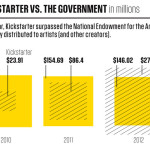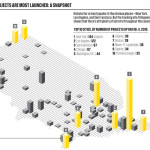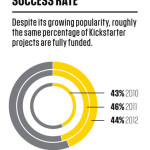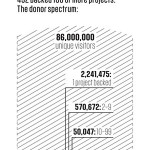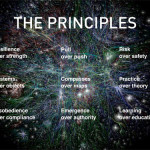A facilitator for commerce moved more money around than a national arts grant system. SHOCK HORROR. In other news the sky is blue and water is fucking wet.
This is why I’ve been working with more and more creators and entrepreneurs on crowdfunding campaigns and why, after I gave big co’s a chance to get onboard a fantastic “Camilla” project and they all got shy about it, we’ll be hitting Kickstarter with something REALLY SPECIAL.
The “d” in d’Errico stands for D-I-Y. You know it!
Infographic: Kickstarter Dominates Indie Innovation
Like YouTube, Facebook, or blogging platforms, it’s almost hard to believe there was an Internet without Kickstarter, which may be the greatest testament to its success. In 2009, the site generated about $23 million for its projects—an impressive figure by all accounts—but in 2012, Kickstarter pulled in roughly 10 times that, leapfrogging the grant budget of the National Endowment for the Arts. You can find all those facts and many more in this masterful infographic created for Fast Company by Catalogtree:
See the full story and infographic here.
And check out Fast Company’s feature story on Kickstarter here.
Kickstarter isn’t endless videos of cute kittens that suck up your time when you should be working… That’s for sure. I don’t think KS is going to not be “cool” for a very long time. Now if only creatives use it & other crowdfunding to fully change the rules of the game instead of propping up the old & tired existing gate keepers to various industries. We have the power now. The *consumer* has the power now.
Media Hacking
Social Media, communications and how the game is changing
Joi Ito’s Principles:
Joi Ito of MIT Media Lab:
Ito: There are nine or so principles to work in a world like this:
1. Resilience instead of strength, which means you want to yield and allow failure and you bounce back instead of trying to resist failure.
2. You pull instead of push. That means you pull the resources from the network as you need them, as opposed to centrally stocking them and controlling them.
3. You want to take risk instead of focusing on safety.
4. You want to focus on the system instead of objects.
5. You want to have good compasses not maps.
6. You want to work on practice instead of theory. Because sometimes you don’t why it works, but what is important is that it is working, not that you have some theory around it.
7. It disobedience instead of compliance. You don’t get a Nobel Prize for doing what you are told. Too much of school is about obedience, we should really be celebrating disobedience.
8. It’s the crowd instead of experts.
9. It’s a focus on learning instead of education.
We’re still working on it, but that is where our thinking is headed.
I don’t believe in market research. I don’t believe in marketing the way it’s done in America. The American way of marketing is to answer to the wants of the customer instead of answering to the needs of the customer. The purpose of marketing should be to find needs — not to find wants.
People do not know what they want. They barely know what they need, but they definitely do not know what they want. They’re conditioned by the limited imagination of what is possible. … Most of the time, focus groups are built on the pressure of ignorance.
It’s there because it works…
Chris Brogan writes (in a great post you need to read here):
How much does one of those opportunities cost? It can’t be cheap to put up a billboard in an airport, right? That same amount would fund a social media project for an entire year, and you’d have clickable metrics for the effort. Wouldn’t that be a better return?
Did Chris remember the name of the company sponsoring the phone/laptop charging station (Samsung)? The Advertising worked (and got the fringe benefit of promotion on Chris’ blog)
Did Chris remember those Vending Machines in the airport (Apple and Best Buy)?? The Advertising worked (” fringe benefit” comment again).
Did Chris remember the 2 billboards before the Hudson News stand? How about the 2 page spread in the middle of this month’s WIRED? The 12 commercials that ran between when you sat down at Fox Sports Bar and when you got up?

Little Guy In The Subway With A Bag of $
The two examples he used (Samsung charging stations and the Apple or Best Buy vending machines) worked because they either provided immediate value (needing to juice up, a HUGE problem in most airports, or chargers, iPods, etc.) or potential future value. They fit within his/yours/my context. If my mom was travelling at the same time, she wouldnt notice who sponsored the power, because she doesnt travel with devices that need power. She might notice the Apple vending machines because they are novel/unique to her, but 5 years from now she will ignore them because they will be commonplace.
Billboards are a “shotgun” approach (with a ton of metrics behind it). The hope is, the right person happens to walk by who happens to have that product or service as part of their context (along with Direct Marketing phone, email, URL to let them find out more AND to let the marketer see effectiveness) or the creative in the ad connects with the user (for a brand campaign – the iconic APPLE ads are a great example of this). In the case of Brand ads, the marketer is paying for impressions (and they pay through the nose – those boards aren’t cheap). In the case of ads with some kind of direct component, the ROI can be (to a certain extent) measured. There are impressions and clickthrough rates to measure against. Is it personal? Nope.
Here is the thing: this stuff, these traditional techniques (print, radio, tv, out-of-home, ad banners, PR, etc.) aren’t going away. Sure, more of the budget is going to digital, but not all of it. There are more of them (less digitally savvy or complete luddites) than there are of us (people reading this, living this, sharing this thing of ours). Marketers still think of us in terms of CONSUMERS and demographics. The reason the old school isn’t going away, the reason we don’t have the advertising apocalypse is because of one thing – IT STILL WORKS.
While we keep saying Social Media is no longer an experiment, we need to keep the marketer’s context in mind. The CMO wants to be innovative, and the brand manager wants to change the world, but both have numbers (leads, impressions, brand value, etc.) that they have to meet to be successful, to grow their brand, get their bonus or in some cases keep their job (the avg lifespan of a CMO is currently something like 22 months). No one ever got fired for doing yet another Direct Mail campaign (where a 1% response rate is considered successful), billboard or tv/radio spot – they are part of the marketing mix. Even ad banners get clickthroughs and they are the “ritz crackers” (low value, not tasty or very effective) of digital advertising.
Small, growing and new brands can go all-in on Digital and Social because they need an edge, and the edge is reach and cost and hopefully shortcut the need for brand recognition and jump right to a relationship. P&G knows it needs Social and is working towards it for the long term (the same thing they did with radio and TV). Ford and GM know they need it, but have to work harder to connect emotionally and with passion (two things that are kinda requirements). If all you do is SELL SELL SELL, its kinda hard to “start a conversation” – you have to invest a lot (time, money, humility) to get respect and to get people to listen. That investment is happening now.
As the Social Media side of Digital grows and matures (and we get more news like the Dell metrics) it can make the case to take a bigger piece of the marketing pie. Digital is no longer sitting at the kids table when it comes to the Agency-Client relationship. Digital is getting more and more budget because it is effective and less expensive and has greater, time-agnostic reach. Sure, we might start shooting commercials for Hulu (or whatever replaces it) and we may see more immersive and experiential and integrated efforts in the future, but the Old School isn’t going away. An ad agency I interviewed a few months ago WILL NOT HIRE an account, strategist or creative without digital in the portfolio or CV. Its becoming that important.
But Social can be the “red thread” that ties the traditional and the digital together, make them more connected, connecting, relevant and responsive. Social (listening, outreach, participatory) can start changing the marketing mindset from campaign to commitment. But that is going to take time.
In 10 years we will have Marketers (CMOs and Brand Managers) who have grown up with Digital in their toolbox from the beginning. Thats when things will start getting weird (in a good way).
:::::::::::::::::::::::::::::::
Like it? Hate it? Leave a comment below 🙂
How NOT To Get The Most Out Of A Conference
Originally posted in the Project Dogfood Website. You should check it out
So you have decided to go to a conference. Maybe you got an invite in the mail or
You drop some hard-earned cash (whether yours or your boss’) on a conference pass. You checked out the conference agenda, picking out the sessions and breakouts and BoF and parties you wanted to attend. You might have looked at the attendees list (if available), seeing who else in your industry, or region or field of interest is also attending.
With conferences now being net-casted on UStream, decks SlideShared, presentations LiveBlogged and Twittered and Utterli’d, why are you going? The content, the data, the decks, the presentations are all, for the most part available. Chris Pirillo, who runs Gnomedex, UStreams and the archives all of the sessions at Gnomedex. IT Conversations business model was the sharing of conference content (pay to get it right away or wait a couple weeks to download it).
The point of going to a conference is to meet people, to engage, to share your ideas not just consume someone else’s deck. Up until 14 years ago, there was an information imbalance between those who have the information about a subject or topic and those of us who wanted to know more. Conferences were meant to give people a chance to meet and share in real time and real space. Sure there were research papers, monographs, journals and books, but they were physical-world artifacts – you had to have them or have access to them.
It was gatherings/conferences/symposia that transformed affinity to community.
So here are my tips for How NOT to Get The Most Out Of A Conference:
1. Don’t approach this as YOUR Conference. You paid, you travelled to get there, you showed up, you are in attendance, and if you really dont want to get the most out of it, then good for you. You get out of it what you put into it… so give the bare minimum and get just that in return! Rock On!
2. Don’t spend the time to find out who else is going to your conference. Don’t use Summize to see who else is mentioning or going to the show (even though hashtags are wonky doesnt mean you cant track the #conference tag). Don’t check UpComing.org, the Conference website or the blogs of the speakers list. Don’t ping the people in your personal network who are also going. Dont make a list of people you want to meet at the show (I have a bunch of folks who I only know thru twtter that I want to meet at New Marketing Summit).
3. Don’t plan your conference experience. Spending time reviewing and understanding the agenda and looking at who is speaking and when is a great way to make sure you miss something you might enjoy or worse, NEED for your job/business/love of the game. Not preparing will result in lots of “session envy” when you find out how much more fun those guys in the other room had.
4. Don’t bother checking out the blogs and sites of the speakers… it helps you determine which are the sessions you want to attend and where the “gold” is at a given show, especially when you are at a multi-track conference – and no one wants that.
5. Don’t be a critical member of the audience. Don’t bother to ask yourself “is this a pitch” when looking at a conference agenda (at some shows the presenters are up there because their company is footing the bill for the mixer or coffee bar or SWAG bag). Be afraid to “vote with your feet” and walk out on a lame/boring/abusive session/speaker. God forbid you look impolite to people you wont bother to talk to.
6. Don’t participate. Don’t feel comfortable enough to ask questions. Be afraid to challenge the masters of the universe on the stage, especially when you disagree or they say something stupid. Make sure you put these folks on a pedestal, even though they are only human. Chris Brogan, Chris Pirillo and Dave McClure all put on some pretty incredible events and always take the time to talk to and appreciate the folks who show up. But you shouldnt approach them. Uh, uh. No way. Most importantly DONT thank or ask questions of the speakers/panelists after their session. They hate that (they dont want to be there either).
7. Don’t mingle. If you can get most of the content elswhere on the web in the comfort of your boxer shorts, why bother going to a show? Especially when 80% of the experience at a conference is the PEOPLE. Don’t spend time in the hallways between sessions. Don’t walk the floor, meeting people, introducing yourself. Don’t make small talk, trade business cards, join BoF discussions. If at all possible, spend as much time at a conference checking your email, answering voicemail messages, polishing your camera lenses and downloading music from iTunes. DO NOT, under any circumstances try to talk to anyone.
If you DONT want to get the most out of your conference experience, then follow the simple tips above. If you WANT to get the most out of the conference, do the exact opposite:
Prepare for the show, read the agenda, pick your sessions, get to know the speakers blogs, ask questions, talk to people, take notes and share them via your own blog and twitter/utterli/etc…
If you really want a black-belt in Conference-Fu, keep an eye out for the wallflowers and shy folks who are keeping to themselves or aren’t going out of their comfort zone- and introduce yourself/say “hi”/introduce them to someone else. Pay it forward.
Take ownership of your conference experience. And plan to have some fun.
Brilliant – Rules for Media Networking
I first met Terry at Gnomedex years ago. Great guy, really understand the broadcast business and how to get users involved.
This post is awesome:
http://www.thepomoblog.com/archive/rules-for-media-networking/
My favorite:
4. Give before you get. As soon as I meet someone new I’m immediately thinking about whether I can help them, not because I want to trade a favor (I may not need anything from them), but because this is how I would like to be treated by them.
Favorite Job Title Ever
CULTURAL ENGINEER
I found this amazing interview with Dave Stewart (musician, former member of the Eurythmics, Social Engineer!) on http://www.digitalnomads.com/2008/08/27/david-allen-stewart-cultural-engineer-on-music-and-technology
He is cooler than me (I couldnt pull off those shades), has more grammys (I dont have any), and has a much better title 🙂
All kidding aside, he is an artist, and by broad definition a cultural engineer.
If you get the chance, check out the interviews on http://www.digitalnomads.com – they seem to be doing some interesting things.
Salaam Garage – Amazing idea, story, presentation & effort
Gnomedex is my FAVORITE conference, and I will keep attending as long as Chris and Ponzi keep throwing this party. This year had the usual eclectic cast of speakers: entrepreneurs, technologists, creatives and media makers. Chris and Ponzi go out of their way to make sure everyone has a great time and this year was no exception. I usually liveblog or shoot video at the event but this year…
My trip to Seattle this year for Gnomedex was interrupted by mild food poisoning, so I missed all of day 1. The Gnomedex team streams each of the sessions/panels/speakers on UStream which then archive the videos. So between the great experience and incredible conversations in the hallways and mixers, you get to relive or share the best of whats onstage.
Over the last couple of weeks I have been watching the videos of what I missed and recently came across Amanda Koster’s presentation on her project, Salaam Garage. An amazing project, Amanda works with NGOs (non-governmental organizations) inside specific countries to develop projects where traveller/media makers can work with the NGOs to tell real, important stories and share them with their communities and favorite digital spaces (Flickr, Facebook, etc.). I guess you might say it would fall under the “documentary tourism” category of adventure travel. Amanda tells the story of her background, how she came up with the idea and how it is going:
http://www.ustream.tv/recorded/655337
I think this is amazing (both the work, the idea and the kind of work they are doing. Amanda also has a book coming out here:
http://www.bennetthastings.com/author.php?author_id=38
The video is about 40 minutes long, and is the kind of thing you would expect from TED, but we have become used to after years of gnomedex
I am so glad Chris and Ponzi shared this with us (and am TICKED I missed it live).
25 years from now…
25 years from now someone in my niece’s graduating class might be the VP pick for the highest office in the land (POTUS). What will that “vetting” process look like? Sure there will be the usual background check stuff, FBI calling their college roommates, PHD advisor, pastor, etc., but what happens in a world where we are declaring our intention and attention (status) all-day, every day. What happens when one of these digital natives, who have been facebooking and myspacing, and flickring and youtube-ing their daily thoughts, ideas, location, and media every day for the next 25 years runs for office?
Past Is Prologue
-William Shakespeare

I had a conversation with my buddy Craig the other day and we discussed how these platforms and models were changing how users interact and part of the discussion touched specifically on:
Right now, every kid under the age of 18 in the US has grown up with potential access to the internet either at home, school, rec center, mom’s office, etc.
For the most part these kids are creating online identities in a ton of places, some are throwaway (to get access to a concert video), and others are permanent (tell my niece she has to quit MySpace and you will end up in a fight).
These kids are getting their own computers (cell phones), self-organizing digitally
They are making their own media (audio, photo, video, text) daily
They are connecting with their friends on these platforms and using them to stay in touch, bully each other, make new friends, etc.
Potentially, this generation will never lose touch with anyone they grew up with – EVER. They graduate from High School Facebook to College Facebook to Work/Life Facebook (or whatever the social platform/graph/grid/mesh evolves to). My niece will be able to keep in touch with, ignore and more importantly, have status on every single kid she is going to high school and college today. I can’t remember every single kid I went to grade school with, but I could probably find a bunch of them on Facebook if I looked hard enough.
Networking? Sure – having the world’s largest, distributed address book in history will make keeping and making connections more interesting.But what happens when you have persistent status of people you know, what they are doing, where they are /were/will be? What happens over time to this data, when it becomes the past tense (was doing, was at, was with)?
Doc Searls has said in a previous VRM meeting that he wants to see a day when the customer can have their own TOS (terms of service) that gives them the right to “nuke my info off your system if I want to quit your proprietary aspect of data”. Outside of the NUKE option (which I think we need), what about an expiration date on my status/intention/attention/media? 15 years from now, does Johnny really want his new girlfriend to see his “Growing Up Gotti” haircut from back in the day? Are those funnel photos from the Preakness really going to be appropriate when your kid decides to “see what mom was like when she was my age”?
Carrying off on this point is a really great and creepy PSA out about kids and the things they are posting to the web:
It changes the game because WE ARE ALL MAINTAINING THE STATUS over our attention/intention/action as well as that of others. There are no reporters, I dont have a secretary, no one is “going to the archives” to find out what I did last week – they just need to follow my twitter feed (which is hooked up to my friendfeed and facebook and wordpress blog) to see what I was doing. Its all in the cache/cloud/reverse chronological order. All someone needs to do is connect the dots (which is getting easier every day).
Your ideas, photos, comments, videos are out there, in the cloud/cache, forever. A persistent, ongoing record, distributed amongst different platforms and social graphs for the world to see. Add in face and voice recognition and that protest rally you went to in college, because that hippy chick you were dating at the time wanted you to go, might become a problem 20 years from now when you run for office, or a job, or meet a not-so-hippy chick. You didnt shoot the video, you didnt know you were on camera, yet it is part of your history. Lots of folks are getting gigs BECAUSE of their participation on these platforms. There are already stories in the “news” (and I do use the term loosely) about how kids are getting turned down for jobs because of things on their myspace page, beauty pageant contestants are losing their crowns because there are embarrassing photos of them on the web, kids are videotaping crimes to get on YouTube.
I hope you know this will go down on your permanent record
– The Violent Femmes
Kiss Off
Things to think about:
Will our past actions prevent us from trying for a job (even Vice President) because we know what closets our skeletons are in (“I told the candidate I could not accept the VP nod because I want to spend more time with my family, and because there are some raunchy pictures of me at my roommates’s bachelor party 17 years ago”)?
Will individuals guard their expressions more closely and be more conscious of their attention/intention/status?
What happens when we run into a “blank slate” who doesnt have a facebook history or is tagged in flickr sets? Will we give them the job/trust/reputation? Will they be a social media pariah?
Will I be able to find a “cleaner” to get rid of all traces of Spring Break 2012 in Cancun before my bride-to-be finds them?
Will there be a “Identity Bankruptcy Court” that will order these graphs and platforms to nuke all traces of someone?
No updates for a month…
Because I have been crankin on client stuff, twittering like mad (more on that later), facebooking, networking, trading tons of emails, working my neck off for my consulting client, planning one startup and launching the phase 1 of another…
And it has taught me so much:
- Editorial is not an afterthought
- Trust is earned
- “Are we done yet” is not professional
- Google Adwords, Google Adsense are magic (and Dave McClure is sooooo right)
- There isn’t enough time in the day
- Going to the US Open with a friend is more fun than watching it on TV
- Pretty much going anywhere is better than watching TV
- You have to be pretty hardcore to compare the NY Yankees to the Republican Party
- Writing the perfect doc or deck is impossible
- There is never enough time, there never will be enough time
- I will be going to Gnomedex as long as Chris and Ponzi invite us
- MadMen is the best show on television
More to come… couple of launches in the next couple months, interesting project for some of my friends, some travel, helping a couple of clients

